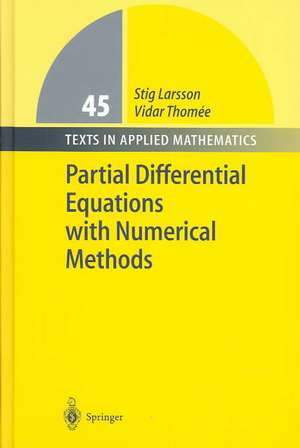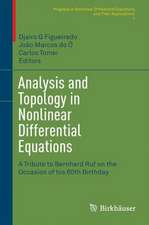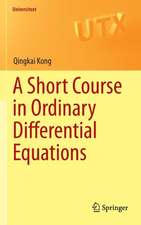Partial Differential Equations with Numerical Methods: Texts in Applied Mathematics, cartea 45
Autor Stig Larsson, Vidar Thomeeen Limba Engleză Hardback – 7 iul 2003
This softcover reprint of a very popular book presents a very well written and systematic introduction to the finite difference and finite element methods for the numerical solution of the basic types of linear partial differential equations (PDE).
| Toate formatele și edițiile | Preț | Express |
|---|---|---|
| Paperback (1) | 528.53 lei 3-5 săpt. | +18.47 lei 7-11 zile |
| Springer Berlin, Heidelberg – 5 dec 2008 | 528.53 lei 3-5 săpt. | +18.47 lei 7-11 zile |
| Hardback (1) | 587.39 lei 6-8 săpt. | |
| Springer Berlin, Heidelberg – 7 iul 2003 | 587.39 lei 6-8 săpt. |
Din seria Texts in Applied Mathematics
- 17%
 Preț: 368.61 lei
Preț: 368.61 lei - 17%
 Preț: 364.42 lei
Preț: 364.42 lei -
 Preț: 494.87 lei
Preț: 494.87 lei - 19%
 Preț: 510.59 lei
Preț: 510.59 lei - 17%
 Preț: 498.74 lei
Preț: 498.74 lei -
 Preț: 463.79 lei
Preț: 463.79 lei -
 Preț: 471.91 lei
Preț: 471.91 lei - 13%
 Preț: 427.17 lei
Preț: 427.17 lei -
 Preț: 447.93 lei
Preț: 447.93 lei - 8%
 Preț: 528.53 lei
Preț: 528.53 lei - 19%
 Preț: 586.76 lei
Preț: 586.76 lei - 15%
 Preț: 461.29 lei
Preț: 461.29 lei -
 Preț: 404.13 lei
Preț: 404.13 lei - 17%
 Preț: 364.52 lei
Preț: 364.52 lei - 17%
 Preț: 363.12 lei
Preț: 363.12 lei - 15%
 Preț: 594.73 lei
Preț: 594.73 lei -
 Preț: 492.20 lei
Preț: 492.20 lei - 15%
 Preț: 606.82 lei
Preț: 606.82 lei -
 Preț: 406.25 lei
Preț: 406.25 lei - 15%
 Preț: 534.60 lei
Preț: 534.60 lei - 18%
 Preț: 1233.03 lei
Preț: 1233.03 lei -
 Preț: 404.13 lei
Preț: 404.13 lei - 15%
 Preț: 662.27 lei
Preț: 662.27 lei - 15%
 Preț: 511.70 lei
Preț: 511.70 lei -
 Preț: 404.89 lei
Preț: 404.89 lei -
 Preț: 399.29 lei
Preț: 399.29 lei -
 Preț: 464.00 lei
Preț: 464.00 lei - 15%
 Preț: 535.34 lei
Preț: 535.34 lei - 15%
 Preț: 681.60 lei
Preț: 681.60 lei - 15%
 Preț: 732.81 lei
Preț: 732.81 lei -
 Preț: 394.87 lei
Preț: 394.87 lei
Preț: 587.39 lei
Preț vechi: 691.05 lei
-15% Nou
Puncte Express: 881
Preț estimativ în valută:
112.39€ • 117.36$ • 92.81£
112.39€ • 117.36$ • 92.81£
Carte tipărită la comandă
Livrare economică 15-29 aprilie
Preluare comenzi: 021 569.72.76
Specificații
ISBN-13: 9783540017721
ISBN-10: 3540017720
Pagini: 280
Ilustrații: X, 262 p.
Dimensiuni: 155 x 235 x 21 mm
Greutate: 0.51 kg
Ediția:2003
Editura: Springer Berlin, Heidelberg
Colecția Springer
Seria Texts in Applied Mathematics
Locul publicării:Berlin, Heidelberg, Germany
ISBN-10: 3540017720
Pagini: 280
Ilustrații: X, 262 p.
Dimensiuni: 155 x 235 x 21 mm
Greutate: 0.51 kg
Ediția:2003
Editura: Springer Berlin, Heidelberg
Colecția Springer
Seria Texts in Applied Mathematics
Locul publicării:Berlin, Heidelberg, Germany
Public țintă
ResearchCuprins
A Two-Point Boundary Value Problem.- Elliptic Equations.- Finite Difference Methods for Elliptic Equations.- Finite Element Methods for Elliptic Equations.- The Elliptic Eigenvalue Problem.- Initial-Value Problems for Ordinary Differential Equations.- Parabolic Equations.- Finite Difference Methods for Parabolic Problems.- The Finite Element Method for a Parabolic Problem.- Hyperbolic Equations.- Finite Difference Methods for Hyperbolic Equations.- The Finite Element Method for Hyperbolic Equations.- Some Other Classes of Numerical Methods.
Recenzii
From the reviews:
"The book under review is an introduction to the field of linear partial differential equations and to standard methods for their numerical solution. … The balanced combination of mathematical theory with numerical analysis is an essential feature of the book. … The book is easily accessible and concentrates on the main ideas while avoiding unnecessary technicalities. It is therefore well suited as a textbook for a beginning graduate course in applied mathematics." (A. Ostermann, IMN - Internationale Mathematische Nachrichten, Vol. 59 (198), 2005)
"This book, which is aimed at beginning graduate students of applied mathematics and engineering, provides an up to date synthesis of mathematical analysis, and the corresponding numerical analysis, for elliptic, parabolic and hyperbolic partial differential equations. … This widely applicable material is attractively presented in this impeccably well-organised text. … Partial differential equations with numerical methods covers a lot of ground authoritatively and without ostentation and with a constant focus on the needs of practitioners." (Nick Lord, The Mathematical Gazette, March, 2005)
"Larsson and Thomée … discuss numerical solution methods of linear partial differential equations. They explain finite difference and finite element methods and apply these concepts to elliptic, parabolic, and hyperbolic partial differential equations. … The text is enhanced by 13 figures and 150 problems. Also included are appendixes on mathematical analysis preliminaries and a connection to numerical linear algebra. Summing Up: Recommended. Upper-division undergraduates through faculty." (D. P. Turner, CHOICE, March, 2004)
"This book presents a very well written and systematic introduction to the finite difference and finite element methods for the numerical solution of the basic types of linear partial differential equations (PDE). … the book is very well written,the exposition is clear, readable and very systematic." (Emil Minchev, Zentralblatt MATH, Vol. 1025, 2003)
"The author’s purpose is to give an elementary, relatively short, and readable account of the basic types of linear partial differential equations, their properties, and the most commonly used methods for their numerical solution. … We warmly recommend it to advanced undergraduate and beginning graduate students of applied mathematics and/or engineering at every university of the world." (Ferenc Móricz, Acta Scientiarum Mathematicarum, Vol. 71, 2005)
"The presentation of the book is smart and very classical; it is more a reference book for applied mathematicians … . The convergence results, error estimates, variation formulations, all the theorems proofs, are very clear and well presented, the annexes A and B summary the necessary background for the understanding, without redundant generalisation or forgotten matter. The bibliography is presented by theme, well targeted on the topic of the book." (Anne Lemaitre, Physicalia Magazine, Vol. 28 (1), 2006)
“Offers basic theory of linear partial differential equations and discusses the most commonly used numerical methods to solve these equations. … There are two appendices providing some extra basic material, useful to help understanding some of the theoretical principles that might be unfamiliar to unexperienced readers and students. The text is elementary and meant for students in mathematics, physics, engineering. … The bibliography is well arranged according to the important issues, which makes it easy to get informed about possible references for further study.” (Paula Bruggen, Bulletin of the Belgian Mathematical Society, Vol. 15 (1), 2008)
"The book under review is an introduction to the field of linear partial differential equations and to standard methods for their numerical solution. … The balanced combination of mathematical theory with numerical analysis is an essential feature of the book. … The book is easily accessible and concentrates on the main ideas while avoiding unnecessary technicalities. It is therefore well suited as a textbook for a beginning graduate course in applied mathematics." (A. Ostermann, IMN - Internationale Mathematische Nachrichten, Vol. 59 (198), 2005)
"This book, which is aimed at beginning graduate students of applied mathematics and engineering, provides an up to date synthesis of mathematical analysis, and the corresponding numerical analysis, for elliptic, parabolic and hyperbolic partial differential equations. … This widely applicable material is attractively presented in this impeccably well-organised text. … Partial differential equations with numerical methods covers a lot of ground authoritatively and without ostentation and with a constant focus on the needs of practitioners." (Nick Lord, The Mathematical Gazette, March, 2005)
"Larsson and Thomée … discuss numerical solution methods of linear partial differential equations. They explain finite difference and finite element methods and apply these concepts to elliptic, parabolic, and hyperbolic partial differential equations. … The text is enhanced by 13 figures and 150 problems. Also included are appendixes on mathematical analysis preliminaries and a connection to numerical linear algebra. Summing Up: Recommended. Upper-division undergraduates through faculty." (D. P. Turner, CHOICE, March, 2004)
"This book presents a very well written and systematic introduction to the finite difference and finite element methods for the numerical solution of the basic types of linear partial differential equations (PDE). … the book is very well written,the exposition is clear, readable and very systematic." (Emil Minchev, Zentralblatt MATH, Vol. 1025, 2003)
"The author’s purpose is to give an elementary, relatively short, and readable account of the basic types of linear partial differential equations, their properties, and the most commonly used methods for their numerical solution. … We warmly recommend it to advanced undergraduate and beginning graduate students of applied mathematics and/or engineering at every university of the world." (Ferenc Móricz, Acta Scientiarum Mathematicarum, Vol. 71, 2005)
"The presentation of the book is smart and very classical; it is more a reference book for applied mathematicians … . The convergence results, error estimates, variation formulations, all the theorems proofs, are very clear and well presented, the annexes A and B summary the necessary background for the understanding, without redundant generalisation or forgotten matter. The bibliography is presented by theme, well targeted on the topic of the book." (Anne Lemaitre, Physicalia Magazine, Vol. 28 (1), 2006)
“Offers basic theory of linear partial differential equations and discusses the most commonly used numerical methods to solve these equations. … There are two appendices providing some extra basic material, useful to help understanding some of the theoretical principles that might be unfamiliar to unexperienced readers and students. The text is elementary and meant for students in mathematics, physics, engineering. … The bibliography is well arranged according to the important issues, which makes it easy to get informed about possible references for further study.” (Paula Bruggen, Bulletin of the Belgian Mathematical Society, Vol. 15 (1), 2008)
Textul de pe ultima copertă
The book is suitable for advanced undergraduate and beginning graduate students of applied mathematics and engineering. The main theme is the integration of the theory of linear PDEs and the numerical solution of such equations. For each type of PDE, elliptic, parabolic, and hyperbolic, the text contains one chapter on the mathematical theory of the differential equation, followed by one chapter on finite difference methods and one on finite element methods. As preparation, the two-point boundary value problem and the initial-value problem for ODEs are discussed in separate chapters. There is also one chapter on the elliptic eigenvalue problem and eigenfunction expansion. The presentation does not presume a deep knowledge of mathematical and functional analysis. Some background on linear functional analysis and Sobolev spaces, and also on numerical linear algebra, is reviewed in two appendices.
Caracteristici
Very well-written Elementary introduction Includes supplementary material: sn.pub/extras












